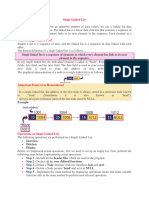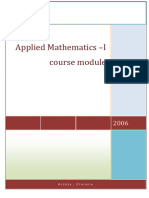0% found this document useful (0 votes)
24 views33 pagesUnit-I Notes Ds (Programs)
The document provides a comprehensive overview of Single Linked Lists, detailing their structure, operations such as insertion, deletion, and display, along with implementation in C programming. It explains how each operation can be performed at different positions within the list and includes code snippets for practical understanding. Additionally, it briefly introduces the concept of stacks using arrays, outlining the basic operations of push and pop.
Uploaded by
viniganesh4Copyright
© © All Rights Reserved
We take content rights seriously. If you suspect this is your content, claim it here.
Available Formats
Download as DOCX, PDF, TXT or read online on Scribd
0% found this document useful (0 votes)
24 views33 pagesUnit-I Notes Ds (Programs)
The document provides a comprehensive overview of Single Linked Lists, detailing their structure, operations such as insertion, deletion, and display, along with implementation in C programming. It explains how each operation can be performed at different positions within the list and includes code snippets for practical understanding. Additionally, it briefly introduces the concept of stacks using arrays, outlining the basic operations of push and pop.
Uploaded by
viniganesh4Copyright
© © All Rights Reserved
We take content rights seriously. If you suspect this is your content, claim it here.
Available Formats
Download as DOCX, PDF, TXT or read online on Scribd
/ 33






















































































